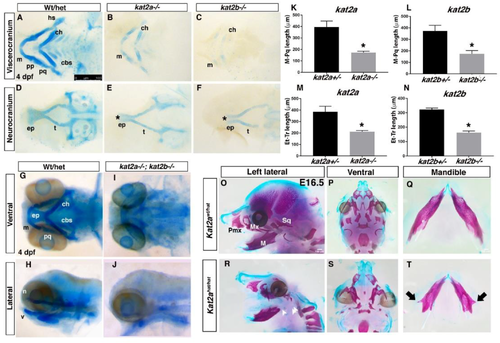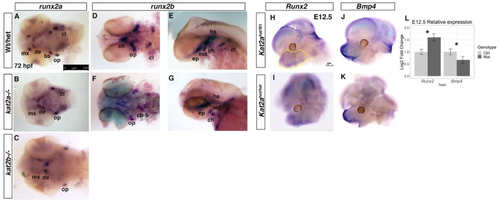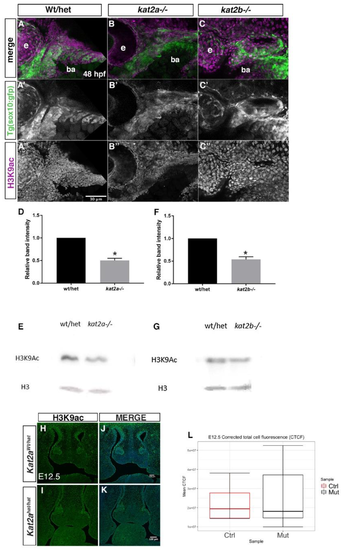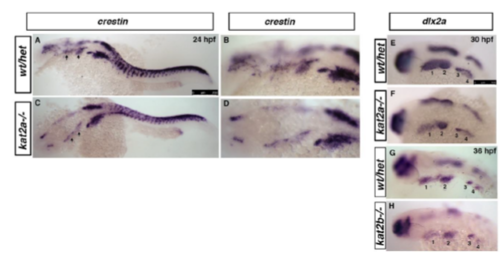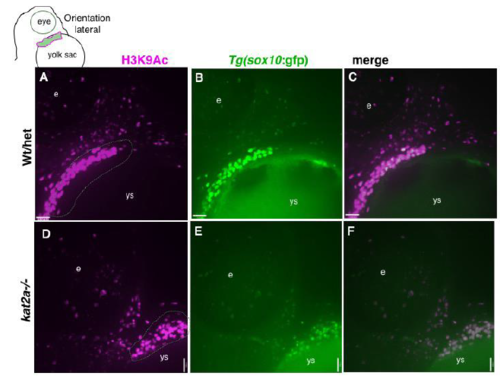- Title
-
Kat2a and Kat2b Acetyltransferase Activity Regulates Craniofacial Cartilage and Bone Differentiation in Zebrafish and Mice
- Authors
- Sen, R., Pezoa, S.A., Carpio Shull, L., Hernandez-Lagunas, L., Niswander, L.A., Artinger, K.B.
- Source
- Full text @ J Dev Biol
|
kat2a and kat2b are broadly expressed throughout the head region during zebrafish development. (A?F) Whole-mount in situ hybridization (ISH) of kat2a and kat2b expression during zebrafish development. Wildtype zebrafish embryos express both kat2a and kat2b in the head region, including the brain, the branchial arches, and the eye. (A,D) Lateral views at 24 h post fertilization (hpf) of expression of kat2a and kat2b. (B,C) Lateral views of wildtype embryos at 40 hpf shows kat2a expression in the eye, the branchial arches, and the otic vesicle. (E,F) Dorsal view at 48 hpf shows kat2b expression in the eye, the branchial arches, and the hindbrain. Lateral views, anterior is to the left. Yellow rectangles in B and E represent the regions shown in C and F, respectively. e, eye; ba, branchial arches; hb, hindbrain; ov, otic vesicle. Scale bars represent 250 ?m (A,D) and 100 ?m (B,E). |
|
Loss of kat2a and kat2b causes defects in craniofacial development. Alcian blue staining to detect cartilage formation in 4 dpf (days post fertilization) wildtype/heterozygote zebrafish embryos (A,D,G,H), kat2a?/? (B,E), kat2b?/? (C,F), and kat2a?/?;kat2b?/? double mutant zebrafish embryos (I,J). (A?F) Cartilage-stained embryos were dissected to separate the viscerocranium and the neurocranium. As compared to the control (A,D), the flat-mounted 4 dpf kat2a (B,E) and kat2b (C,F) mutant larvae have a reduced palatoquadrate, including the pterygoid process of the palatoquadrate and the hyosymplectic of the viscerocranium, shortening of the Meckel?s cartilage, widening of the angle between ceratohyals in the viscerocranium, a smaller hypoplastic ethmoid plate, and deformed trabeculae of the neurocranium, with hypoplastic ceratobranchial cartilages that are also reduced in number. In the kat2a and kat2b mutant embryos, there is a gap in the anterior edge of the ethmoid plate that forms a ?cleft? as shown (*) in (E,F). Cartilage defects were observed in n = 17/62 for kat2a and n = 16/66 for kat2b, with the total number of mutant embryos being n = 20/72 for kat2a and n = 17/70 for kat2b in each clutch. (G?J) Ventral and lateral views of whole-mount, alcian-blue-stained cartilage of control (G,H) and kat2a?/?;kat2b?/? double mutants (I,J). (K?N) Quantitation of length in micrometers (Ám) from Meckel?s cartilage to palatoquadrate (M?Pq), and from ethmoid plate to trabeculae (Et?Tr), in kat2a and kat2b mutants shows a significant reduction in length. * denotes statistical significance (p < 0.05) using Welch?s T-Test. Error bars show the standard error of the mean. (O?T) Whole-mount E16.5 Kat2aWt/hat (O?Q) and Kat2ahat/hat (R?T) embryo skeletons stained with alcian blue for cartilage and alizarin red for bone. (O,R) Left lateral view of skull. (P,S) Ventral view of skull with the mandible dissected off. (Q,T) Dorsal view of the dissected mandible. The arrows in T point to ectopic bone growth on the mandible (ectopic bone growth observed in n = 3). The arrow heads in R point to the missing first arch elements. cb, ceratobranchials; ch, ceratohyal; e, ethmoid plate; hs, hyosymplectic; Mx, Maxilla, M, Mandible; m, Meckel?s cartilage; n, neurocranium; pp, pterygoid process; pq, palatoquadrate; Pmx, Pre-maxilla; Sq, Squamosal; t, trabeculae; v, viscerocranium. The scale bars represent 100 ?m. |
|
Cartilage progenitor expression of sox9 and col2a1 is reduced in kat2a?/? and kat2b?/? zebrafish embryos and E12.5 Kat2ahat/hat mice. Whole-mount in situ hybridization for zebrafish sox9a (A?L) and col2a1 (M?O) in wildtype or heterozygous embryos (A?D,M), kat2a?/? (E?H,N), and kat2b?/? (I?L,O) zebrafish embryos at 48 hpf (A,B,E,F,I,J) and 72 hpf (C,D,G,H,K?O). Lateral views (A,C,E,G,I,K), and ventral views (B,D,F,H,J,L?O), with the anterior to the left in all cases. At both stages, sox9a and col2a1 expression is reduced in the forming cartilage elements. At 48 hpf, there is an overall reduction, especially in the anterior expression domain of sox9a (E, F and I, J as compared to control (A,B)). At 72 hpf, the number of cartilage elements is reduced, especially in the ceratobranchial cartilages in both kat2a (G,H,N) and kat2b (K,L,O) as detected with both sox9a and col2al. For sox9, n = 8/33 for kat2a, n = 7/30 for kat2b. For col2a1, n = 7/29 for kat2a, n = 7/31 for kat2b. (P?S) Sectional in situ hybridization with a Sox9 antisense probe on mouse E12.5 Kat2aWt/hat (P?R) and Kat2ahat/hat (Q?S) cryosections through the frontonasal prominence (P,Q) and the mandibular prominence (R,S) as schematized in the diagram of a E12.5 embryo adapted from the eHistology Atlas (T, the red bar indicates the plane of transverse sections). M = Meckel?s cartilage, T = Tongue. (U) RT-qPCR quantification of Sox9 and Col2a1 expression with RNA extracted from the facial prominences of control (Kat2aWt/hat; CTRL on graph) and mutant (Kat2ahat/hat; MUT on graph) E12.5 mouse embryos. Expression was normalized to GusB, n = 4. The Y-axis shows the Log2 fold change of the relative gene expression, following the ddCT method; * denotes statistical significance (p < 0.05) using Welch?s t-Test. The error bars show the standard error of the mean. cbs1-5, ceratobranchials 1-5; ch, ceratohyal; ep, ethmoid plate; m, Meckel?s cartilage; n, neurocranium; pas, pharyngeal arches. The scale bars represent 100 ?m. EXPRESSION / LABELING:
PHENOTYPE:
|
|
The bone progenitor markers runx2a and runx2b are differentially expressed in kat2a?/? and kat2b?/? zebrafish embryos and Kat2ahat/hat mouse embryos. In situ hybridization for runx2a (A?C) and runx2b (D?G) in WT or heterozygous (A,D,E), kat2a?/? (B,F,G), and (C) kat2b?/? 72 hpf zebrafish embryos. (A?D,F) ventral views, (E,G) lateral views, with the anterior to the left in all. kat2a?/? (B) and kat2b?/? (C) show reduced expression of runx2a, especially in the anterior maxilla, whereas expression in the dentary bone remains strong as compared to controls (A). runx2b expression in forming bone elements is reduced overall in kat2a mutants (F,G) compared to the control (D,E). For runx2a, n = 9/34 for kat2a, n = 8/31 for kat2b. For runx2b, n = 8/30 for kat2a, n = 8/29 for kat2b. (H?L) Whole-mount in situ hybridization with Runx2 and Bmp4 antisense probes on mouse E12.5 Kat2aWt/hat (H,J) and Kat2ahat/hat (I,K) embryos. (L) RT-qPCR quantification of Runx2 and Bmp4 expression with RNA extracted from E12.5 facial prominences of control (Kat2aWt/hat; Ctrl on graph) and mutant (Kat2ahat/hat; Mut on graph) embryos. The yellow outline in (H) marks the area dissected for RNA extraction. Gene expression was normalized to GusB, n = 4. The Y-axis shows the Log2 fold change of the relative gene expression, following the ddCT method; * denotes statistical significance (p < 0.05) using Welch?s t-Test. The error bars show the standard error of the mean. Neural tube closure defects are evident in Kat2ahat/hat mutants. bs, branchiostegal ray; cb-5, ceratobranchial-5; ch, ceratohyal; cl, cleithrum; de, dentary; ep, ethmoid plate; hs, hyosymplectic; md, mandible; mx, maxilla; op, opercle. The scale bars represent 100 ?m. EXPRESSION / LABELING:
PHENOTYPE:
|
|
Histone H3 lysine 9 acetylation (H3K9Ac), an active transcription mark, is reduced in kat2a?/? and kat2b?/? zebrafish. (A?C?) Maximum projection confocal micrographs of 48 hpf zebrafish embryos labeled to detect H3K9Ac immunofluorescence (A??C?, magenta in A?C) and neural crest cells expressing transgenic sox10:GFP (A??C?, green in A?C). Lateral views with the anterior to the left; e, eye; ba, branchial arches. kat2a?/? and kat2b?/? zebrafish mutants show an overall disorganization of neural crest cells in the branchial arches as well as a reduction of H3K9Ac. (B,C) as compared to control (A). Western blots and quantification for H3K9Ac in kat2a?/? (D,E) and kat2b?/? (F,G) using 48 hpf zebrafish whole embryos relative to total histone H3 expression; * denotes statistical significance (p < 0.05) using Welch?s t-Test. The error bars show the standard error of the mean. (H?K) Immunofluorescence with the H3K9ac antibody and a DAPI counterstain on mouse E12.5 Kat2aWthat control (H,J) and Kat2ahat/hat mouse mutant (I,K) cryosections through the frontonasal prominence, with merged images of H3K9ac and DAPI (J,K). (L) Quantification of corrected total fluorescence cell intensity (CTCF). Total fluorescence was corrected for background and area; Measurements were made using ImageJ, n = 2. Kat2aWt/hat is Ctrl on graphs, Kat2ahat/hat is MUT on graphs. No significance was found for the mouse data. The scale bars represent 30 ?m for zebrafish and 100 ?m for mice. |
|
Expression of kat2a and kat2b in is reduced in mutants; genotyping strategy for kat2a and kat2b mutants, heterozygotes and WTs. Lateral views of in situ hybridization for (A) kat2a in kat2a-/- and (B) kat2b in kat2b-/- zebrafish at 36 hpf. (C) Genotyping PCR to distinguish between kat2a wildtype, heterozygotes (het, +/-) and mutants (-/-). PCR was performed with primers designed to amplify the TALEN target region in exon 1 of kat2a. PCR products were digested with SacI, an enzyme whose target sequence that lies within the TALEN site, and whose sequence is altered in the TALEN mutants. Band patterns of digested products indicate their genotype as labeled. (D) Genotyping PCR to validate mutagenesis of kat2b by CRISPR/Cas9. Left panel shows PCR amplification of kat2b exon 6 CRISPR target region using primers targeted to that region. PCR followed by T7 Endonuclease I yields the respective band patterns as labeled. Right panel shows PCR amplification of kat2b exon 6 CRISPR target region using a dCaps forward primer designed against the mutant sequence. Digestion of PCR product by AciI yields the respective band patterns as labeled. Scale bars represent 250 ?m. |
|
crestin and dlx2 expression are slightly reduced in kat2a-/- and kat2b-/-. In situ hybridization for crestin (A?D) at 24 hpf, and dlx2a (E-H) at 30 hpf and 36 hpf as labeled. Zebrafish embryos used are wt or het (A, B, E, G), kat2a-/- (C, D, F), and kat2b-/- (H). Arrowheads (A,C) indicate pharyngeal arches, which are numbered 1-4 (E-H). Scale bars represent 250 ?m (A, C) and 100 ?m (EH). |
|
H3K9Ac is reduced in kat2a-/- mutants. Confocal micrograph for antibody staining of H3K9Ac (A, D), sox10:GFP (B, E) in wt (A?C) and kat2a-/- (D?F) whole-mount zebrafish embryos at 48 hpf, in lateral views oriented as indicated in schematic. e, eye, ys, yolk sac. Scale bars represent 100 ?m. |


